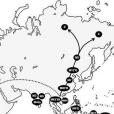《Carriers of mt DNA macrohaplogroup M colonized India from SE Asia》是一本圖書
基本介紹
- 外文名:Carriers of mt DNA macrohaplogroup M colonized India from SE Asia
- 出版時間:2016年11月10日
- 頁數:45 頁
- ISBN:9788137617070
內容簡介
First, we think that the exit from Africa followed a northern route across the Levant, and that the fossils of early modern humans at Skhul and Qafzeh could be signals of this successful dispersal. These first modern humans carried undifferentiated mtDNA L3 lineages and brought primitive core-flake technology to Eurasia [26]. The dates estimated for Skhul and Qafzeh remains (Ad)...(展開全部) First, we think that the exit from Africa followed a northern route across the Levant, and that the fossils of early modern humans at Skhul and Qafzeh could be signals of this successful dispersal. These first modern humans carried undifferentiated mtDNA L3 lineages and brought primitive core-flake technology to Eurasia [26]. The dates estimated for Skhul and Qafzeh remains (Additional file 2: Table S4) are slightly out of the range calculated for the age of mtDNA macrohaplogroup L3 (78.3, 95 % CI: 62.4; 94.9 kya) based on ancient mtDNA genomes [137]. However, they are in accordance with the presence of early modern humans in China around 100 kya, and with their subsequent presence in southeastern Asia about 70 kya. If we add the fact, also based on ancient genomes, that mtDNA lineages in northern Asia already belonged to derived B and U haplogroups around 45 kya [126, 127], we opine that the geneticists should resynchronize the mtDNA molecular clock with the Levant and East Asia fossil records instead of consider them as result of unsuccessful migrations. Second, those early modern humans went further northwards, some at least to the Altai Mountains, and in the way they occasionally mixed with other hominids as Neanderthal and Denisovans. Harsh climatic conditions dispersed them southwards erasing the mtDNA genetic footprints of this pioneer northern phase [31]. Third, the small surviving groups already carried basic N and M lineages. One of them, with only maternal N lineages, spread southwards to present-day southern China and probably, across the Sunda shelf re

